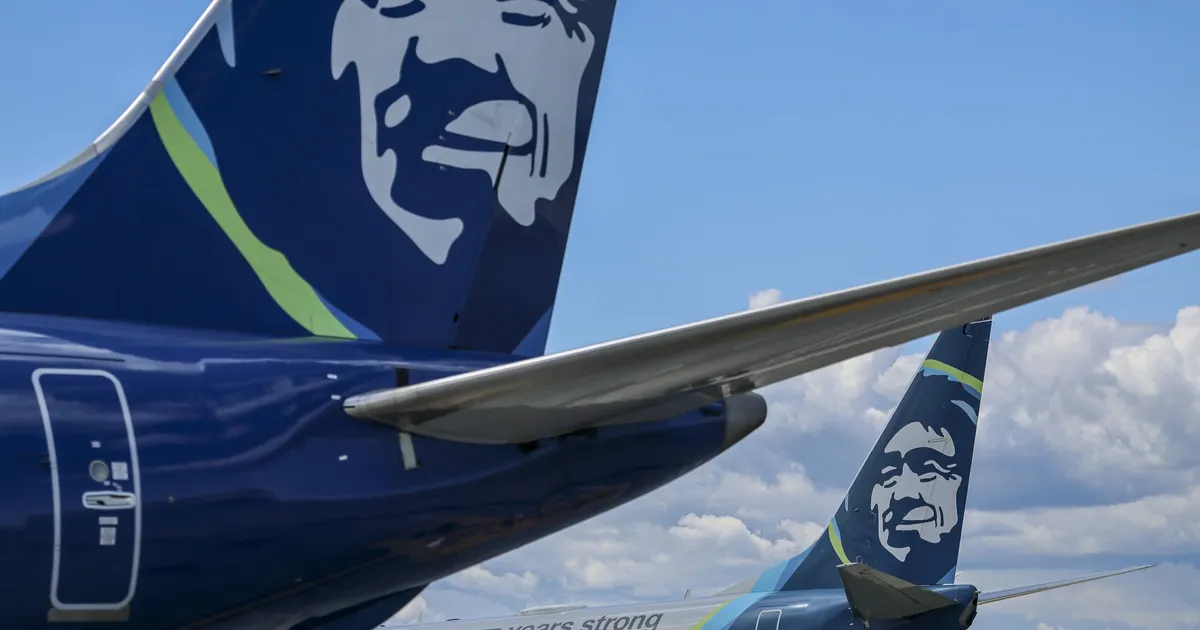Carl LaFraugh already anticipated a lengthy travel day when his vacation in Skagway, Alaska, came to an end. He planned to catch a red-eye flight from Juneau to Sea-Tac Airport early Monday morning.
But then a hardware failure in Alaska Airlines’ computer network forced the airline to pause its flights for around three hours Sunday night. The carrier first reported the outage around 8 p.m., which persisted until 11 p.m. By the time flights resumed, their schedules were scrambled, with around 200 flight cancellations as of Monday morning.
LaFraugh first learned about the major disruption to the airline’s service by reading The Seattle Times’ weekend coverage. Still, for over an hour, he said, his flight remained on schedule to leave at 1:55 a.m. — until delays slowly pushed the departure time to 7 a.m. Finally, it was canceled.
“They don’t notify passengers immediately, and they string passengers along with how their flight plans will be resolved,” LaFraugh said.
The Renton resident was one of many travelers affected by the ground stop for Alaska and Horizon Air flights, which Alaska Airlines continued addressing Monday.
In a statement, Alaska Airlines pointed to an “unexpected failure” of a crucial piece of hardware at its data centers that led to the outage.
“When that happened, it impacted several of our key systems that enable us to run various operations, necessitating the implementation of a ground stop to keep aircraft in position,” the statement read. “The safety of our flights was never compromised.”
A ground stop means affected aircraft cannot take off.
Alaska Airlines said the hardware tied to the outage is produced by a third party, and it’s working with the vendor to replace it. The carrier declined to provide further information when asked about the purpose of the hardware.
Alaska Airlines said the outage is not tied to outside events or a cybersecurity incident. Cybersecurity bugs have made recent global headlines as hackers target Microsoft, with the tech giant scrambling to patch defects in its SharePoint web application.
Federal Aviation Administration spokesperson Cassandra Nolan directed a request for further details about the outage to Alaska Airlines.
The event also held up the carrier’s crews.
The Association of Flight Attendants-CWA, the union representing Alaska and Horizon Air flight attendants, said, “When planes are grounded, crews are delayed and stranded like passengers. When delays and operational changes like this occur, contractual work rules kick in to make sure Alaska and Horizon Flight Attendants are protected and compensated.”
The union emphasized that “safety and security must come first.”
But it took some effort on LaFraugh’s end to make it home.
After learning about his flight cancellation, he called Alaska Airlines’ customer care team — only to encounter a wait time of almost six hours to speak to an agent, LaFraugh said.
Instead, he rushed to speak with an airline representative at Juneau International Airport. With around 100 patrons queuing behind him, LaFraugh was rebooked onto another morning flight.
After landing in Seattle, he described the airport as “a zoo,” with throngs of people packed in the hallways.
Because Alaska Airlines is headquartered in the Seattle area and LaFraugh holds an elite member status, he’ll keep booking with the carrier. “But there’s certainly great room for improvement,” he added.
Last year, Alaska Airlines requested multiple ground stops tied to tech problems.
In December, the carrier grounded flights at Seattle-Tacoma International Airport for 40 minutes due to an IT issue, which also affected its Cyber Monday sale. That followed major disruptions reported in September when Alaska Airlines had to ground its planes because of another technology mishap. And in April, the airline grounded its flights for an hour while it handled an issue that occurred as its system was upgraded.
However, it’s not the only carrier that’s been forced to make that decision in recent years. Southwest Airlines had to ground its planes around the country in April 2023. It blamed “data connection issues resulting from a firewall failure,” according to reporting at the time.
John Nance, a Friday Harbor-based aviation analyst for ABC World News and Good Morning America, said it’s the first time he’s heard any large airline attribute a major disruption, such as Alaska Airlines’ latest ground stop, to a piece of hardware.
“Like, 90% of the time, it’s software,” said Nance, who is also a retired Alaska Airlines captain.
However, he emphasized that safety remains a top priority in the airline industry. In order to maintain that sense of security, “at the first sign of trouble, they’ll put the airline on the ground,” Nance said in a phone interview Monday. “And that is hugely expensive, as you can imagine.”
While it causes a temporary mess for Alaska Airlines, Nance explained that the carrier — not the FAA — made the call to ground its flights out of an abundance of caution, and that’s an example of the system working well.
“The FAA sets minimum standards,” Nance said. “You don’t want to fly — or even taxi — on an airline that considers that to be their standard. That is always the bottom.”
Nance doesn’t believe the public needs to be concerned about this incident, though he encourages it to continue demanding transparency from the government and airlines.
Ultimately, “Alaska is growing,” Nance said, “and there are growing pains that go along with that.”
